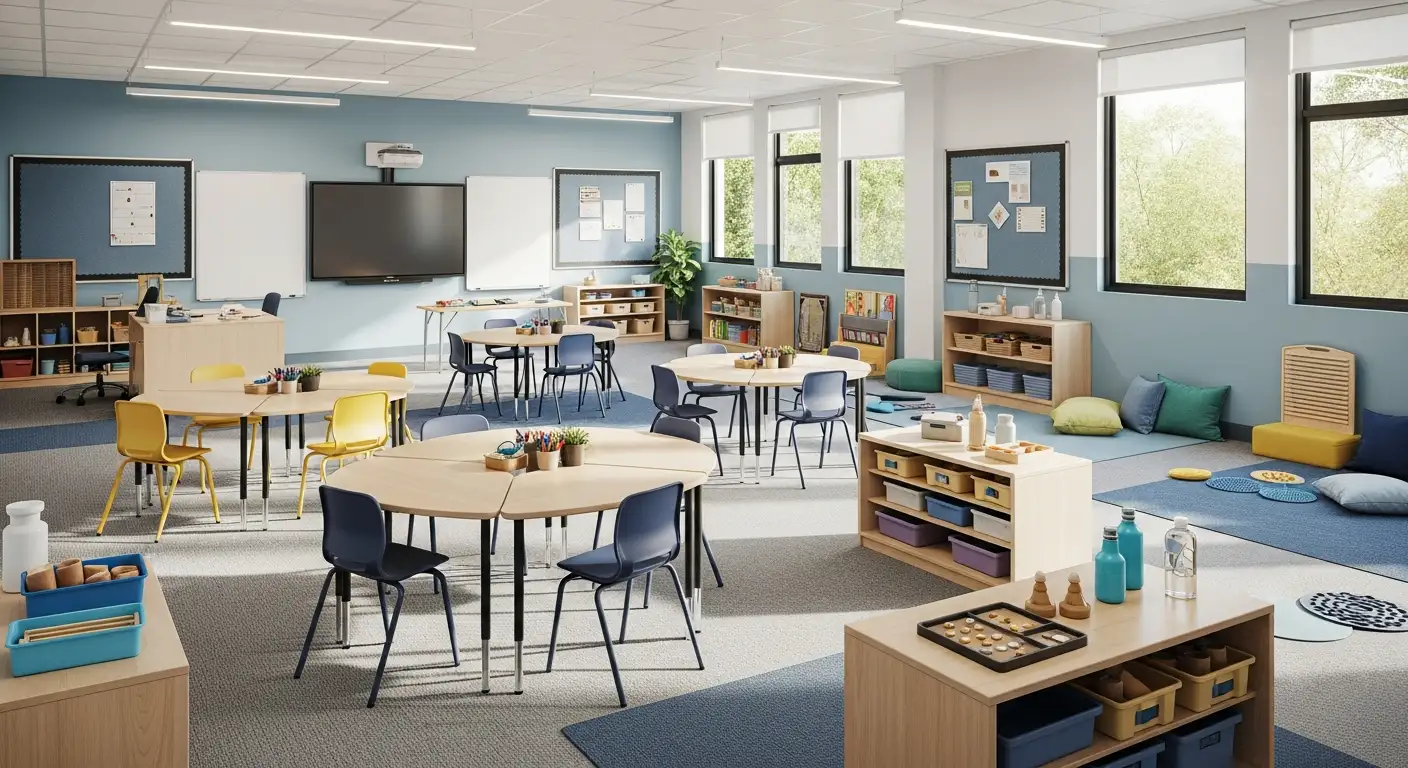Introduction to Visual Supports in Autism Therapy
Visual supports are powerful tools in therapy for individuals with autism spectrum disorders (ASD). Leveraging images, schedules, and instructional aids, these tools help make abstract concepts more concrete, improve understanding, reduce anxiety, and promote independence. This article explores how to create and implement visual supports effectively within the framework of Applied Behavior Analysis (ABA) therapy, a scientifically validated intervention method for autism.
Understanding ABA Therapy and Its Role in Autism Intervention

What is Applied Behavior Analysis (ABA) therapy and how does it help individuals with autism?
Applied Behavior Analysis (ABA) therapy is a scientifically validated approach designed to understand and improve specific behaviors in individuals with autism. Rooted in behavioral science, ABA applies principles like reinforcement and prompting to teach new skills and reduce challenging behaviors.
Foundations of ABA Therapy
Core elements of ABA include:
- Reinforcement: Providing rewards to encourage desired behaviors.
- Prompting: Offering cues or hints to help individuals perform target behaviors.
- Data Collection: Systematically measuring behavior through frequency, duration, or interval recording to evaluate progress and adjust interventions.
These elements work together to create effective, personalized treatment plans.
How ABA Helps Individuals with Autism
Early, intensive ABA interventions have been shown to lead to significant developmental improvements. By reinforcing positive behaviors and using prompts to support learning, ABA helps children develop crucial skills such as social interaction, communication, and self-care.
ABA is typically delivered by qualified professionals like Board Certified Behavior Analysts (BCBAs) and behavior technicians in settings that include homes, clinics, and schools. This flexibility ensures child-centered, tailored support.
Role of Behavior Analysis Techniques in ABA
Behavior analysis in ABA emphasizes understanding the relationship between antecedents (what happens before a behavior), behaviors themselves, and consequences (what follows). This A-B-C model guides the design of interventions aimed at encouraging beneficial behaviors and reducing problem behaviors.
Consistent data collection helps monitor the effectiveness of strategies and informs necessary adjustments. Techniques such as visual supports enhance ABA by making instructions clearer and more accessible, especially for children who respond well to visual learning.
Overall, ABA therapy empowers individuals with autism to build skills that enhance their independence and quality of life through structured, evidence-based methods.
Role of Professionals in Delivering ABA Therapy

Who typically provides ABA therapy for autism?
ABA therapy is delivered by a team of trained professionals who specialize in behavioral analysis. The primary providers include Board Certified Behavior Analysts (BCBAs), Registered Behavior Technicians (RBTs), and Licensed Behavior Analysts (LBAs). BCBAs take the lead by designing customized treatment plans based on thorough assessments and ongoing data collection. They ensure that each intervention is tailored to the individual needs of the child.
RBTs and behavior technicians are responsible for implementing these plans on a daily basis, working directly with children to teach new skills and manage behaviors. Their role is crucial for consistent application of therapy strategies under BCBA supervision. Other therapists trained in behavior techniques may also participate, especially within various settings.
What are the responsibilities of BCBAs and behavior technicians?
BCBAs oversee all aspects of the therapy process. They conduct assessments, interpret data, develop intervention programs, and adjust techniques as needed to maximize progress. Their expertise allows them to evaluate the effectiveness of treatment regularly and support families in understanding therapeutic goals.
Behavior technicians and RBTs execute the individualized plans, providing direct care and reinforcement to children. They use structured teaching methods, prompting, and visual supports as directed. Their hands-on interaction is essential for helping children learn new behaviors and skills in real-time.
Where is ABA therapy typically delivered?
ABA services are provided across diverse environments to promote skill generalization. Common settings include the child's home, clinics, schools, and community locations. This flexibility ensures that interventions fit naturally into daily routines and social contexts. Delivery by skilled professionals within these various settings supports consistent intervention and enhances developmental outcomes for children with autism.
Key Techniques in ABA Therapy and Integration of Visual Supports

What are the common techniques used in ABA therapy?
ABA therapy employs several effective techniques to help children with autism learn new skills and modify behaviors. Discrete Trial Training (DTT) breaks tasks into small, manageable steps, allowing focused teaching. Natural Environment Teaching (NET) encourages learning through everyday activities, promoting generalization of skills. Task analysis also breaks down complex tasks into simpler parts for easier mastery.
Central to ABA are reinforcement strategies. Positive reinforcement involves providing rewards—like praise or tokens—to encourage desired behaviors. Negative reinforcement entails removing an unpleasant stimulus to increase behavior frequency. Prompting offers hints or cues to guide the child toward the correct response, which are gradually faded to promote independence. Modeling demonstrates the desired behavior for children to imitate.
Additional strategies such as behavior chaining link simple steps together into complex actions. Techniques like extinction (withholding reinforcement for unwanted behaviors), redirection, and functional communication training (FCT) target behavior reduction while supporting communication skills. Behavior contracts set clear expectations and consequences, supporting consistency.
How do visual supports complement ABA methods?
Visual supports are a vital complement to ABA, especially for individuals with autism who often process visual information more effectively than verbal cues. Tools like visual schedules, instructional cards, pictures, line drawings, and written words enhance understanding and communication.
Visual schedules map out daily routines, reducing anxiety by providing predictable structure. They pair visual cues with spoken instructions, aiding comprehension. Consistent use and regular updating of visual supports promote independence and decrease problematic behaviors.
Personalized visual tools such as social stories help navigate social situations by presenting scenarios visually and verbally. Visual vocabulary supports language development and clarifies expectations. Together, these visuals work alongside ABA techniques by providing clear, concrete prompts and reinforcement cues, facilitating skill acquisition and behavioral progress.
How are reinforcement, prompting, and modeling used in ABA therapy?
Reinforcement rewards motivate repetition of positive behaviors, while prompting helps a child reach a target behavior by offering supportive hints. Modeling teaches by example, enabling children to imitate and learn social and practical skills. These techniques are often combined in a stepwise fashion, starting with prompting and modeling, then shifting toward independent behavior as reinforcement strengthens learning outcomes.
ABA therapists tailor these methods to each child's needs, often incorporating visual supports to enhance clarity and engagement. This multifaceted approach helps children with autism develop crucial cognitive, social, and communication skills effectively and sustainably.
Scientific Evidence Behind ABA Therapy Effectiveness
What evidence supports the effectiveness of ABA therapy for individuals with autism?
Extensive research provides strong evidence supporting the effectiveness of ABA therapy in improving outcomes for individuals with autism.
Meta-analyses have demonstrated that ABA therapy leads to substantial gains in IQ scores, with an effect size of about 0.740. Communication and language skills also show notable improvements (effect sizes between 0.650 and 0.742). Adaptive behaviors—especially those related to socialization and communication—are significantly enhanced through targeted interventions. These outcomes highlight ABA therapy’s importance in promoting core skills necessary for independence and social participation.
Research supporting ABA therapy
Contemporary ABA approaches have evolved to include naturalistic and play-based methods that are interest-driven. This evolution promotes engagement, enjoyment, and skill-building in a context meaningful to the child. Behavioral strategies such as reinforcement and prompting are delivered consistently to encourage desirable behaviors and reduce challenges.
Outcomes in IQ, communication, and behavior
The consistent use of ABA therapy helps children develop essential cognitive and social skills. Early and intensive therapy often results in improved IQ scores, enhanced language acquisition, and better social functioning. These improvements support long-term development and facilitate greater autonomy.
Importance of early and individualized interventions
Early intervention—ideally initiated before age three—appears especially effective. Tailoring ABA programs to each child’s individual strengths, needs, and learning preferences maximizes progress and supports meaningful growth. Personalized plans, involving families and specialists, ensure continuity and consistency across home and educational settings.
Overall, ABA therapy stands as an evidence-based method with strong scientific backing, demonstrating measurable benefits across several developmental domains for individuals with autism.
Why Visual Supports Are Essential in Autism Therapy

Benefits of visual learning for autism
Visual learning is particularly important for individuals with autism spectrum disorders (ASD), as many respond better to information presented visually rather than through auditory means. This preference helps children grasp concepts more effectively and participate actively in therapy sessions. Using images, instructional cards, and visual schedules, therapists can communicate expectations clearly, aiding in comprehension and engagement.
Visual aids helping comprehension and routine
Visual aids such as objects, photos, line drawings, and written words support understanding and language development. Visual schedules, in particular, serve as useful tools to help children comprehend daily routines by pairing visual representations with spoken instructions. This combination assists children in anticipating upcoming activities, making transitions smoother and improving their ability to follow instructions consistently.
Reducing anxiety and promoting communication
The regular use of visual supports reduces anxiety by providing predictability and structure, which is often comforting for children with autism. These tools enhance communication skills by allowing children to express needs and understand social cues more easily. When visual supports are consistently used and regularly updated, they promote independence and reduce problematic behaviors, making everyday interactions less stressful for both children and their families.
Types of Visual Supports and Their Practical Applications

Visual schedules and instructional cards
Visual schedules are powerful tools that help children with autism by visually representing daily routines and activities. They reduce anxiety by providing clear, consistent expectations and help improve communication skills when paired with spoken instructions. Instructional cards serve as simple, portable reminders of tasks or behaviors, aiding children in understanding and following steps independently.
Use of images, photos, and line drawings
Images, photos, and line drawings are essential visual aids in supporting comprehension and language development. These visual tools make abstract concepts more concrete and accessible, fostering better understanding and engagement. Their use aligns well with the visual learning strengths often observed in individuals with autism, making learning more intuitive and enjoyable.
Implementation of social stories and visual vocabulary
Social stories and visual vocabulary supports are personalized teaching tools designed to navigate social situations and enhance communication abilities. Social stories break down and explain social cues and expectations in a structured way, while visual vocabulary cards provide ready-made prompts for language use. Together, they support the development of social skills and help individuals with autism manage their interactions more confidently.
Steps to Creating Effective Visual Supports for Therapy
Starting Simple and Modeling Behaviors
When introducing visual supports in ABA therapy, it is important to begin with simple tasks and clear visual aids. Visual schedules, instructional cards, and images can be used to model desired behaviors. This helps children with autism understand expectations and learn new skills through clear examples.
Consistent Practice with Visual Aids
Regular practice with these visual supports reinforces learning. Using consistent cues such as images or written words alongside verbal instructions strengthens comprehension and encourages children to follow routines and instructions reliably.
Gradually Increasing Complexity
As children become more comfortable with basic tasks, the complexity of visual supports should be increased gradually. For example, after mastering single-step instructions with visual aids, two-step instructions can be introduced. This stepwise progression promotes cognitive development, autonomy, and social skills.
Regular Updating and Customization
To maintain effectiveness, visual supports need to be regularly updated and tailored to individual needs. Collaborating with special education professionals and family members ensures that the tools remain relevant, personalized, and supportive of each child’s progress and changing abilities.
Tools and Resources to Enhance Visual Support Implementation
Educational Apps and Literature
Educational apps designed for autism therapy provide interactive and engaging visual supports, making learning more accessible for children with autism. These apps often include customizable visual schedules, instructional cards, and social stories tailored to individual needs, supporting cognitive and social skill development.
Complementing digital tools, specialized literature offers caregivers and professionals evidence-based strategies and practical guidance on integrating visual supports effectively into daily routines.
Parent Support Groups and Collaboration
Parent support groups play a crucial role in autism therapy by facilitating shared experiences, offering emotional support, and providing practical advice for implementing visual supports at home. These groups encourage consistent use of strategies across environments, which is vital for progress.
Regular collaboration between families and therapists ensures that visual support tools remain personalized and relevant. This partnership fosters a family-first approach, promoting consistency and reinforcing learning outcomes.
Involving Special Education Professionals
Special education professionals bring expertise in tailoring visual supports to meet the unique learning profiles of children with autism. Their involvement ensures that interventions are evidence-based and adapted as needed.
By working closely with behavioral therapists and families, these professionals help create comprehensive teaching plans that integrate visual supports effectively, promoting communication, independence, and positive behavior.
Together, these tools and collaborative efforts enhance the implementation of visual supports, maximizing their benefit for children with autism.
Implementing Two-Step Instructions Using Visual Supports
Promoting cognitive development and autonomy
Two-step instructions with visual supports play a crucial role in enhancing cognitive skills and fostering autonomy in children with autism. By breaking down tasks into manageable parts, children can focus on one instruction at a time, making complex activities easier to understand and complete. Visual supports such as pictures, charts, or instructional cards serve as clear reminders that help guide the child's actions independently, gradually reducing reliance on adult prompts.
Improving social skills through visual cues
Visual cues integrated into two-step instructions also support social skill development. For example, using visual schedules or social stories can teach children when to take turns, respond to greetings, or follow group activities. These aids improve the child’s ability to interpret social settings and respond appropriately, enhancing communication and interaction with peers and adults alike.
Consistency in practice to reinforce learning
Consistent use and practice of two-step instructions with visual supports are essential to reinforce learning and generalize skills across environments. Regular repetition helps solidify understanding and encourages the child to apply these skills in daily routines. Coupled with positive reinforcement strategies, consistent practice leads to meaningful progress in behavior and skill acquisition.
Overall, implementing two-step instructions with visual supports is an evidence-based approach that promotes cognitive growth, independence, and improved social engagement for children with autism. When applied regularly and thoughtfully, it enhances learning outcomes and supports the child’s journey toward greater independence.
The Family-First Approach in Using Visual Supports within ABA Therapy
Collaboration with Families
A family-first approach is central to effective ABA therapy, especially when incorporating visual supports. Families play an essential role by working closely with behavior analysts, therapists, and educators to tailor visual tools to each child's unique needs. This collaboration ensures that visual aids such as schedules, instructional cards, and social stories are meaningful and relevant to the child's daily experiences.
Ensuring Consistency Across Settings
Consistency in the use of visual supports is crucial for maximizing their benefits. Families, therapists, and educators coordinate to apply visual learning strategies uniformly across home, school, and clinical environments. By regularly updating visual schedules and reinforcement systems together, they create predictable routines that reduce anxiety and increase a child's ability to follow instructions.
Supporting Independence and Behavior Management
Visual supports developed through family collaboration encourage autonomy and aid behavior management. When parents and professionals use visual cues effectively, children with autism gain clearer understanding of expectations and routines, which minimizes problematic behaviors. This shared, consistent approach nurtures social skills development and enhances communication, empowering the child to navigate various environments more independently.
Conclusion: Empowering Therapy Through Visual Supports
Creating and employing well-designed visual supports plays a critical role in enhancing therapy outcomes for individuals with autism. By integrating visual tools within ABA therapy, therapists can improve communication, reduce anxiety, promote independence, and foster essential life skills. Collaboration among professionals, families, and caregivers ensures these supports are personalized and consistently applied, maximizing their effectiveness. As evidence continues to affirm ABA's benefits, visual supports remain a cornerstone in delivering compassionate, evidence-based care that uplifts individuals with autism on their developmental journeys.
References
- 2 Step Instructions ABA: A Step-by-Step Guide for Parents
- Effective Visual Learning Strategies for Autism Success
- Incorporating ABA Therapy into Everyday Life for ...
- The Controversy Around ABA
- The effectiveness of applied behavior analytic interventions ...
- Applied Behavior Analysis (ABA)
- Applied Behavioral Analysis (ABA) Therapy
- Path 2 Potential | In-Home Autism & ABA Treatment



